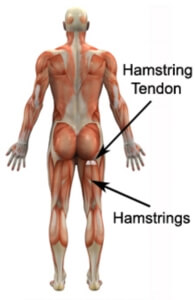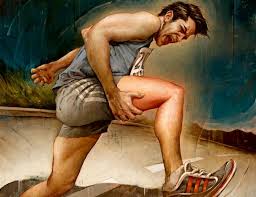My son has had High Hamstring Injury starting in October during football season. He is able to work through it, but when he sprints, he says he feels it the most and it is annoying. He is going into baseball season and I don’t want him to hurt worse. Thanks for giving us the idea of eccentric lifting and self massage. Your video said to email you for more. Thanks for your help.
Signed,
Hamstring Harry
Hi Harry,
The problem with high hamstring injuries is that they often start out as a small problem, one that an athlete can work around. Because we have 4 hamstrings it is easy to compensate for a small injury to one of them only to eventually result in a tear of the high hamstring tendon. These injuries can then become problematic causing severe pain and limiting athletic activity. They also result in the athlete visiting therapist upon therapist, receiving differing opinions and diagnosis and spending countless hours and dollars only to find themselves in a worsened condition. I can say this after years of taking histories of young athletes when they present to our clinic. Of course an accurate diagnosis is key to determining the proper course and degree of treatment. In order to differentiate a high hamstring injury from other injuries such Ischial bursitis or Gluteus Medius Syndrome a thorough exam performed by someone with intricate knowledge of these conditions and how to differentiate them followed by an MRI is usually necessary to avoid future occurrence’s and possibly surgery.

Once the exact diagnosis is achieved for a High Hamstring injury there are many treatment and rehabilitation options. Doing hamstring eccentric training can be an effective ingredient in successfully rehabilitating this injury. Of course that is assuming it is done with
- Correct form to target the high hamstring
- Correct load in order to not overload and further damage the tendon
- Correct number of reps to properly stimulate the tendon to grow and heal
- Proper synergistic therapies to stimulate growth and repair of the High Hamstring Tendon. Let’s look at what some of these therapy options are
Therapy Options for High Hamstring Injuries
Rest
Not a day goes by that a patient tells me they did R.I.C.E (Rest, Ice, Compression and Elevation) for their High Hamstring Injury. When questioned further they will usually admit that their version of rest was about 1-3 days which is often not enough. Depending on the severity of the High Hamstring injury you may require up to 4-6 weeks of rest. This is not something a runner or athlete usually wants to hear but may be necessary.
Self Massage
Self massage can be done effectively and conveniently without the aid of a therapist. Light to moderate pressure should be used using a stick roller or a foam roller. In order to be effective it must be done without too much pressure, a couple of minutes 2-3 daily and without causing further pain (usually by using too much pressure on the high hamstring). It is not unusual for patients to tell me they were sitting and rolling around on a lacrosse ball and that their hamstring would hurt worse after. This is because they used to much pressure and the lacrosse ball did not have enough surface area to distribute the pressure effectively.
Stretching
Static and dynamic stretching can be effective in rehabilitating High Hamstring injuries. It is important that the stretch is done for short duration (20-30 seconds), frequently (every waking hour) and within a normal physiologic range of motion (no yoga moves!). In other words the stretch to the High Hamstring should be gentle and not painful. Dynamic stretching of the High Hamstring can be done by performing moves that would “warm up” the High Hamstring like leg swings.
Strengthening
Strengthening your High Hamstring following injury is important but if it is employed too early in the rehabilitative process can be detrimental. Different types of strengthening can be employed at different stages of the High Hamstring injury depending on the severity. In the early stages try isometric strengthening and then as the High Hamstring is healing begin light concentric movements. Once the High Hamstring is feeling 90-100% begin eccentric strengthening which is known to stimulate the tendon to strengthen in response to strain.
Platelet Rich Plasma Therapy (PRP)
PRP is an injection of your own white blood cells into the damaged High Hamstring Tendon. This can stimulate increase blood flow and repair cells into the tendon and increase the chances for effective healing. PRP should be looked at as a synergistic therapy to regular rehabilitative principles and not a stand alone intervention.
Myofascial Release, ART, Graston Technique, Gua Sha etc.
The above names describe the process when a therapist will perform direct and specific massage to the High Hamstring Tendon. This can help to stimulate blood flow and repair cells to the tendon. Normally this is done 2-3x a week in the clinical setting for up to 10 minutes per session. It is important that the therapist does not use too much pressure causing more damage to the High Hamstring Tendon. If you are in more pain following a session then your therapist is probably using too much pressure. Bruising following treatment is another sign that too much pressure is being used.
Ultrasound
Ultrasound waves can be used on the High Hamstring injury to increase blood flow and repair cells to the tendon. It does this by causing friction on the tendon which in turn dilates blood vessels which then allows for the increase in blood flow. Session can last 10-15 minutes and are typically done 2-3x a week and in conjunction with other therapies such as myofascial release and electrical stimulation
Electrical Stimulation
Electrical current can be used on the High Hamstring Tendon to cause small contractions. When you contract a muscle-tendon complex blood flow is increase to provide the cells with the fuel they need to preform continuous contraction. Electrical stimulation is normally performed 2-3x a week and done in conjunction with other therapies such as myofascial release and ultrasound. Our office will also supply a patient with a High Hamstring Injury a portable electrical unit that can be worn under clothing and used throughout the day.
Altered Gravity Treadmill Rehabilitation (AlterG)
Altered Gravity technology has been available since 2012. It allows the clinic to “unweight” a patient with High Hamstring Injury thus allowing them to walk or run safely and without further pain or injury. By reducing someones body weight you reduce the stress on the High Hamstring Tendon. This allows for a progressive resistance program of walking uphill or running to begin at a much earlier stage of the rehabilitative process. As the High Hamstring Tendon repairs and heals body weight is added back to the patient by the AlterG computer. Progressive resistance stimulates the High Hamstring to heal while walking uphill or running allows the patient, runner or athlete to maintain their cardiovascular fitness while their High Hamstring is healing. This is advantageous to the athlete because they can return to normal athletic activity almost immediately following the rehab protocol.
For more information in hamstring injuries visit our website
If you have any questions please email info@sdri.net or to schedule an appointment call 858-268-8525
The medical information on this site is provided as an information resource only, and is not to be used or relied on for any diagnostic or treatment purposes. This information is not intended to be patient education, does not create any patient-physician relationship, and should not be used as a substitute for professional diagnosis and treatment.


Leave A Comment